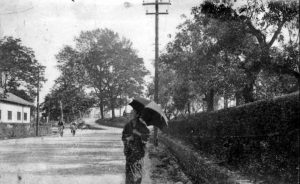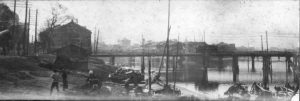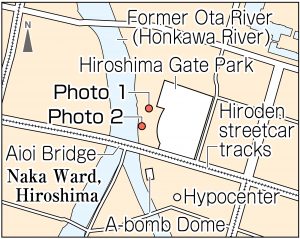Striving to fill voids in Hiroshima—Recreating cityscapes: In Motomachi area, tree-lined road, everyday lives of people
Jul. 22, 2024
by Kyoko Niiyama, Staff Writer
A photograph of a woman holding an umbrella and people pedaling bicycles along a tree-lined road reveals a moment in the everyday lives of the people of Hiroshima. The photo was taken around 100 meters upstream along the former Ota River (present-day Honkawa River) from the east end of Aioi Bridge, located on the north side of the A-bomb Dome in Hiroshima’s Naka Ward. The photo of the city’s Motomachi area is thought to have been taken in the early Showa period (1926–1989).
The photo was in an album at the home of Isao Kataoka, 76, who manages the bag shop “Kataoka Store,” established in 1897, in the area of Tokaichi in Hiroshima’s Naka Ward. The person who took the photo is unclear.
Motomachi, where the Hiroshima Castle is located, and its surrounding areas were home to numerous military facilities after establishment of the Imperial Japanese Army’s Fifth Division in Japan’s Meiji era (1868–1912). The West Drill Ground was to the east of the location where the photo had been taken. The area was a symbol of Hiroshima as a “military city.” According to Hironobu Ochiba, chief curator at the Hiroshima Peace Memorial Museum, “With few photos showing the surroundings in the area, this photo is valuable.”
There is another valuable photograph, this one taken from the banks of the former Ota River (Honkawa River) looking downstream toward the east end of Aioi Bridge. The Hiroshima Electric Railway Company’s Yaguranoshita substation and the round roof of the Prefectural Industrial Promotion Hall (present-day A-bomb Dome) can be seen in the photo. Many houses and shops in what used to be known as the Nakajima district are lined up on the other side of the bridge, an area that is now Peace Memorial Park. The photo is thought to have been taken between 1912 and 1932, a time during which the use of Aioi Bridge was limited to streetcars.
The entire area was devastated in the atomic bombing. After the war, shacks stood along the river where many A-bomb survivors huddled together to live. In recent years, the area continues to be transformed through redevelopment, including a project that has turned the former Hiroshima Municipal Baseball Stadium, the post-war home field of the professional Hiroshima Toyo Carp baseball team, into Hiroshima Gate Park.
(Originally published on July 22, 2024)
A photograph of a woman holding an umbrella and people pedaling bicycles along a tree-lined road reveals a moment in the everyday lives of the people of Hiroshima. The photo was taken around 100 meters upstream along the former Ota River (present-day Honkawa River) from the east end of Aioi Bridge, located on the north side of the A-bomb Dome in Hiroshima’s Naka Ward. The photo of the city’s Motomachi area is thought to have been taken in the early Showa period (1926–1989).
The photo was in an album at the home of Isao Kataoka, 76, who manages the bag shop “Kataoka Store,” established in 1897, in the area of Tokaichi in Hiroshima’s Naka Ward. The person who took the photo is unclear.
Motomachi, where the Hiroshima Castle is located, and its surrounding areas were home to numerous military facilities after establishment of the Imperial Japanese Army’s Fifth Division in Japan’s Meiji era (1868–1912). The West Drill Ground was to the east of the location where the photo had been taken. The area was a symbol of Hiroshima as a “military city.” According to Hironobu Ochiba, chief curator at the Hiroshima Peace Memorial Museum, “With few photos showing the surroundings in the area, this photo is valuable.”
There is another valuable photograph, this one taken from the banks of the former Ota River (Honkawa River) looking downstream toward the east end of Aioi Bridge. The Hiroshima Electric Railway Company’s Yaguranoshita substation and the round roof of the Prefectural Industrial Promotion Hall (present-day A-bomb Dome) can be seen in the photo. Many houses and shops in what used to be known as the Nakajima district are lined up on the other side of the bridge, an area that is now Peace Memorial Park. The photo is thought to have been taken between 1912 and 1932, a time during which the use of Aioi Bridge was limited to streetcars.
The entire area was devastated in the atomic bombing. After the war, shacks stood along the river where many A-bomb survivors huddled together to live. In recent years, the area continues to be transformed through redevelopment, including a project that has turned the former Hiroshima Municipal Baseball Stadium, the post-war home field of the professional Hiroshima Toyo Carp baseball team, into Hiroshima Gate Park.
(Originally published on July 22, 2024)










